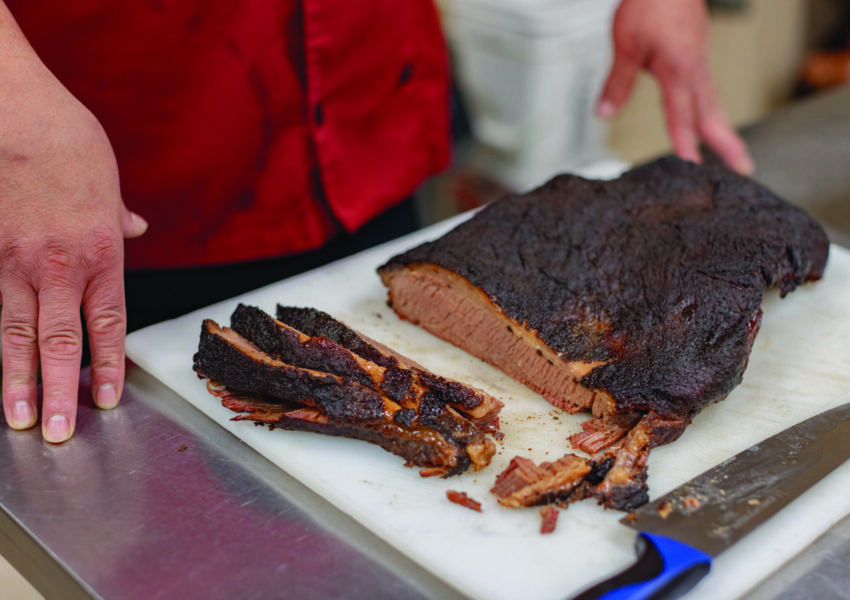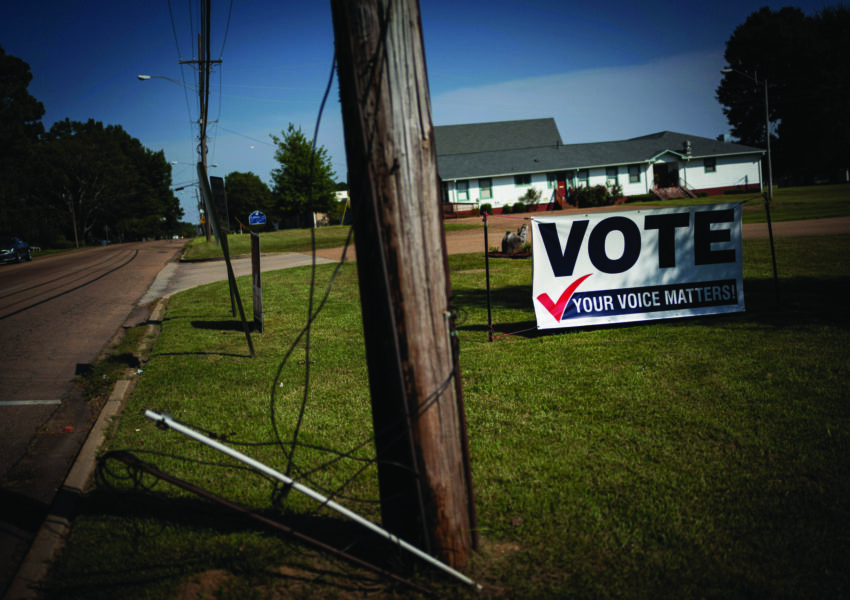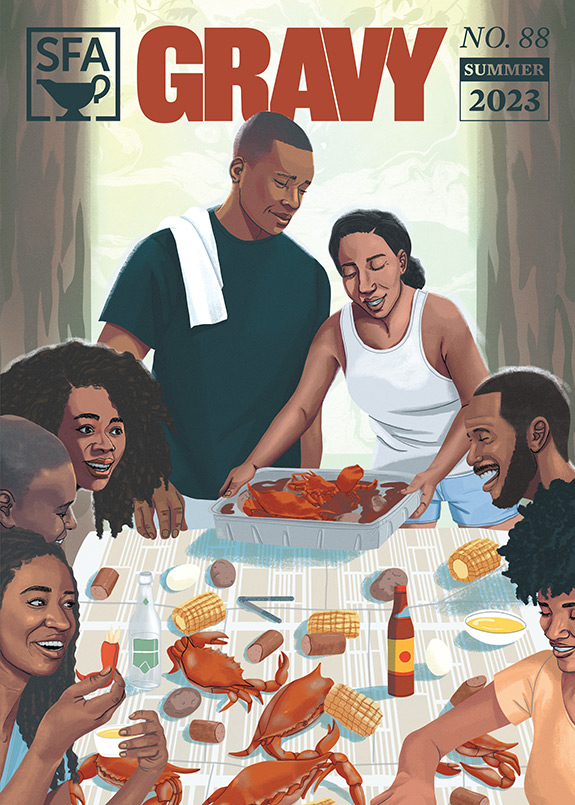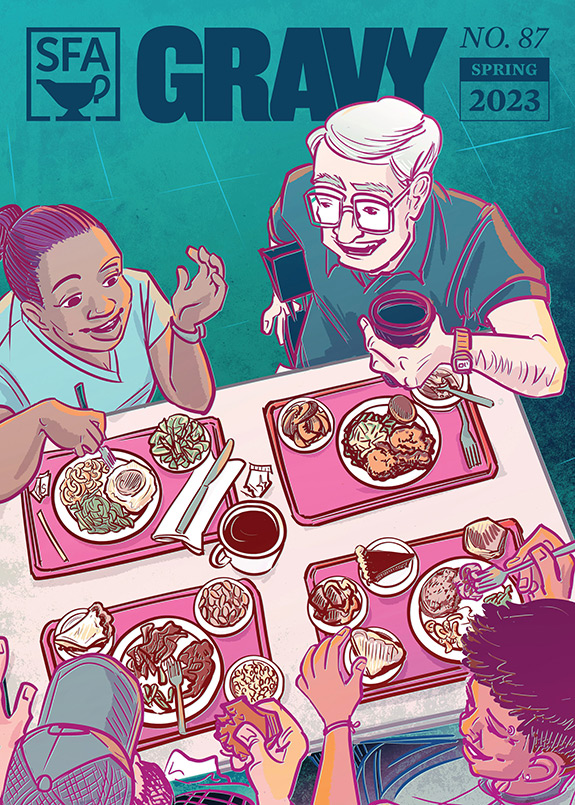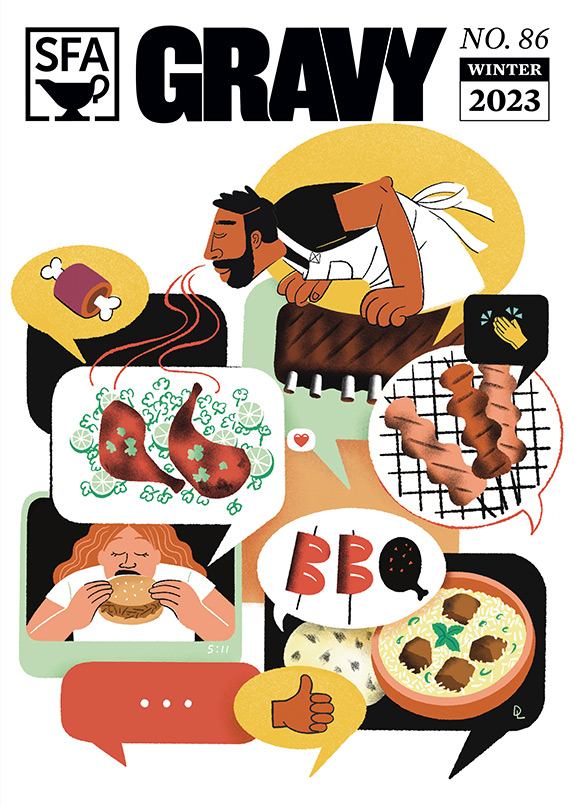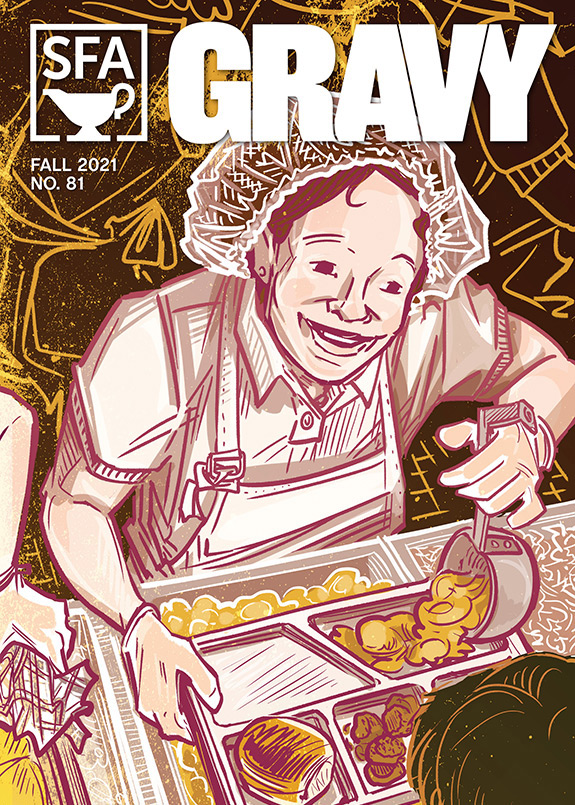This article first appeared in issue #53 of our Gravy quarterly. The author, Angela Jill Cooley, is an assistant professor of history at Minnesota State University-Mankato. She was the SFA’s first postdoctoral foodways fellow.
Golden Arches & White Spaces
Race in Early Fast-Food Places
by Angela Jill Cooley
Much attention is given to the role of the lunch counter in the years leading up to the Civil Rights Act of 1964. But what about the fast-food chain, which was rising to national prominence at the same time? Angela Jill Cooley addresses this question in an excerpt from her book, To Live and Dine in Dixie: The Evolution of Urban Food Culture in the Jim Crow South, forthcoming from the University of Georgia Press.
When he launched his North Carolina-based fast food chain, Wilber Hardee already had a great deal of experience in food service. Before World War II, he ran a snack shop behind a gas station in rural North Carolina. The venture offered a way for his family to survive the economic depression without leaving their farm. After the war, Hardee opened a family restaurant called the Silo, serving barbecue, steaks, seafood, hamburgers, and fried chicken.
In the postwar economic boom, Hardee lived comfortably with his wife and four children. He didn’t need to invest in a new restaurant concept. But Hardee was intrigued by a drive-in called McDonald’s. “Probably everyone in the restaurant business began about the same time to hear stories of the new hamburger chain that served hamburgers instantly for only fifteen cents,” he recalled in his memoir. North Carolina’s first McDonald’s franchise opened in Greensboro. One Sunday, he took the 200-mile drive to witness a long queue of customers, dressed in their Sunday best, who parked their cars, stood in line, and purchased bags of hamburgers at the walk-up window.
As he drove home, Hardee planned his own restaurant. He began with the charbroiled hamburgers he already served at the Silo and chose a site in Greenville with a large parking lot near East Carolina College to take advantage of the automobile traffic. Following the McDonald’s model, he constructed a small building with no dining room. Ceramic tiles gave the structure a clean, modern facade. On September 3, 1960, the first Hardee’s opened. There were no other fast-food restaurants in the vicinity. Customers traveled as far as fifty miles for the grand opening. Hardee later recalled it as “one of the proudest days of my business career.”
Hardee’s story reflects the evolution of Southern foodways in the post-World War II period. As the region began to prosper, more Southerners could afford to eat out. Hardee was one of the first Southerners to recognize and capitalize on the fast-food chain. Broad economic and demographic changes, including migration into the Sunbelt, threatened white privilege in Southern eating spaces, carefully constructed during the first part of the century. Yet white supremacy was a component of the business models adopted by white Southern entrepreneurs like Hardee.
Increasingly after World War II, national chain stores and restaurants became standard features of the Southern landscape. National chains fed Southern appetites and imaginations. Southerners recognized the potential. The region’s temperate weather, automobile culture, and suburban migration contributed to an atmosphere in which fast food thrived.
Fast-food chains were spectacles of modernity that linked Southern consumers to national economic and cultural patterns. With national marketing, simple designs, and inexpensive fare, fast food should have represented a threat to white privileged eating spaces. In the early years, fast-food restaurants had no dining rooms to segregate. But these spaces built white privilege into the key features of their concepts.
Two brothers, Richard and Maurice McDonald, developed the fast-food concept in San Bernardino, California. Initially, they operated a traditional drive-in with carhops serving items like barbecue and hamburgers to a customer base dominated by teenagers. In 1948, to increase their sales volume, the McDonald brothers streamlined operations. They eliminated the carhops, popularizing a new style of drive-in where customers walked up to a service window. They also reduced the menu to hamburgers, cheeseburgers, french fries, milk shakes, and soft drinks.
Over the next decade, as Ray Kroc franchised its operations, McDonald’s spread across the country and throughout the Southern states. As population growth shifted from the Northeast to the South and Southwest, Kroc recognized the potential of the Sunbelt for the success of the national chain.
Southern entrepreneurs like Wilber Hardee saw the value of providing a relatively inexpensive meal to an increasingly suburban population no longer concentrated in downtown areas. Hardee’s and other Southern fast-food chains explicitly modeled the McDonald’s design.
By its nature, fast food had the potential to be a more democratic mode of consumption. The McDonald brothers and Kroc purposefully scaled down the process of eating out. “What we have attempted to do is eliminate those things that people don’t eat,” Kroc explained in a 1961 Time magazine article. “You can’t eat a 20% tip, a perfumed finger bowl or a waitress.”
That philosophy promised access for all. There was no drive-in, no drive-through, no dining room, no lunch counter, no waiters or waitresses. Everyone walked up to the window and ordered. Then, customers took their orders to the car or elsewhere to eat. (McDonald’s did not implement indoor seating until 1963.) The industry relied on low prices and high volume. On the surface, fast food did not discourage consumption by anyone.
From the beginning, national chains depended on standardization of goods and services to ensure brand loyalty. A customer could expect the same products and quality in Columbus, Georgia, that she received in Springfield, Massachusetts. Creating a national corporate identity for one chain should have made discriminatory policies difficult, unreasonable, and embarrassing. White Southerners should have had to work hard to maintain white supremacy and segregation in these public spaces.
White supremacy and racial segregation nevertheless prevailed, especially in the South, in the earliest years of fast food. At that time, national corporations tended to leave human-resource and customer-service policies to the discretion of the local manager of franchisee and community law or custom. In his 2001 book Fast Food Nation, Eric Schlosser points out that McDonald’s now regulates all aspects of its operations, down to the diameter of the pickles on the hamburgers, but allows local managers to handle employee-related issues such as salary, hours, and benefits. According to Schlosser, this lenience allows local wage rates to prevail, virtually eliminates overtime for most hourly workers, and inhibits union influence.
In the 1950s and 1960s the chain used the same laissez-faire approach to customer relations, allowing local law, custom, and manager preference to dictate service to African Americans. Like the earlier five-and-dime lunch counters, the local franchises of modern fast-food chains retained autonomy over service issues. White Southern entrepreneurs who started fast-food chains and purchased national franchises maintained local racial mores.
There is little evidence of how black Southerners negotiated the walk-up service windows that all customers used in the early years of fast-food service. But discriminatory customs dictating that whites be served before black customers may have regulated the racial interactions at McDonald’s service counters.
Automobiles and suburban shopping centers encouraged proprietors to build away from downtown areas. In the postwar era, white Southerners tended to move away from the cities into the suburbs. Restaurant location and residential segregation may have limited black access to these public spaces. Wilber Hardee located his first Hardee’s hamburger restaurant near a college that, at the time, admitted only white students.
Segregation and discrimination were practiced at McDonald’s locations and at other chains in the South. Three years after activists, merchants, and city officials negotiated to desegregate the downtown lunch counters in Greensboro, North Carolina, students staged a stand-in demonstration at the local McDonald’s, which, despite lacking a dining room, refused to allow equal service. When McDonald’s implemented indoor seating, in the midst of civil rights sit-in activism, many Southern franchisees practiced racial segregation even when other local eateries had abolished the practice.
By the summer of 1963, most of the downtown lunch counters in Pine Bluff, Arkansas, had already desegregated. But not McDonald’s, which civil rights activists began to target with protests. When the franchisee obtained an injunction requiring the protestors to cease their direct action campaigns, local civil rights activists called for a national boycott of McDonald’s.
The laissez-faire policies of those chains aided companies like McDonald’s in constructing national identities that reinforced white supremacy. From the start, Kroc marketed to white, middle-class, Protestant families. And he prohibited pay telephones, jukeboxes, and vending machines to discourage loitering or disruptions that he thought would “downgrade the family image.” Corporate portraits illustrating McDonald’s idealized operations reveal the significance of the white middle-class family to the company identity during the early franchise era. Later, the chain amplified the family feel of the company by introducing the new slogan, “The Closest Thing to Home.” In the South, however, only whites were made to feel welcome in that home.



